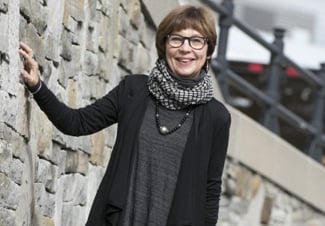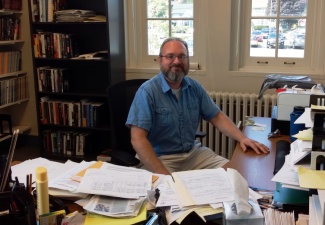Department of Theatre to Present Moliere's 'Tartuffe'
PLATTSBURGH, N.Y. (Oct. 19, 2009) -- SUNY Plattsburgh's Department of Theatre is bringing one of Molier's most entertaining and enduring plays to campus in a Main Stage production."Tartuffe" will open Thursday, Nov. 5, at 7:30 p.m. in Hartman Theatre located in the Myers Fine Arts Building. Performances will continue at 7:30 p.m. on Friday, Nov. 6, and Saturday, Nov. 7, and at 2 p.m. on Sunday, Nov. 8. Tickets may be purchased in advance at the Angell College Center desk and at the door. Prices are $10 for general admission; $8 for seniors, students and SUNY Plattsburgh faculty and staff; and $2 for SUNY Plattsburgh students.
Dr. John Shout, professor of Theater and English, will direct this comedy about religious hypocrisy, seduction and greed. According to Shout, the play remains as relevant today as when it was first written almost 350 years ago.
"'Tartuffe' is one of the most frequently performed plays in the long canon of theater history," explained Shout. "Precisely because the things they found funny in the 17th century, we still find funny today."
"Tartuffe" is the story of a conman, who plots and schemes his way into the household of a rich fool by presenting himself as a holy man. Not everyone is convinced, however, and the fun begins as Tartuffe sets out to steal the man's women and family fortune. The play was first performed in 1664 for King Louis XIV. Although well received by audiences, it was quickly banned because of objections from influential church leaders.
But above all, "Tartuffe" is a comedy, and, as Shout puts it, "It is an old fashioned, knock-down, thigh-slapping comedy. We're prepared to guarantee you a lot of laughs."
SUNY Plattsburgh's production features performances by 11 students and the efforts of many students, alumni, faculty and staff behind the scenes. The stage design by Dr. Timothy Palkovic has been source of pride for the cast and crew. The play is set in the home of a middle class family, trying to make their residence look like the Palace of Versailles. The master of the house is redecorating with images that reflect his new found religious fervor.
One of the challenges Palkovic faced in designing the set was building a palatial room with what he calls "the economy of our means." For example, "instead of sculptures, we used enlargements of period art to suggest paintings," explains Palkovic.
"But the significant scenic element is the curved staircase," said Palkovic, "because it reflects the pretentiousness of the family and their desire to impress." A typical house of the Baroque period would have a straight staircase without sweep and grandeur.
For shows like this, researching period architecture, interior design and costumes is all part of the preparations. The costume designer and the set designer confer early on to finalize a color palette and review the scale of the show with respect to the visual impact.
For costume designer Marie Barber, this show called for historical research and the opportunity to work with taffetas, lace, velvet and silks. "I looked at art, engravings, and paintings from the 1600s to get an idea of what people were wearing, and the differences in dress by social class, " explains Barber. "Men's fashions began to change during this period. Their clothing reflected much pomp and circumstance as well as the reaction against such opulence," said Barber.
For Barber, the 14 designer outfits meant finding and adapting appropriate patterns; a trip to Syracuse for fancy fabrics; and the purchase of accessories via the Internet.
"If you've never made it to a live theater show, make it your first. You'll enjoy
it," said Barber. "It will be a feast for the eyes as well as a whole lot of fun."
News
Knelly Named Special Adviser to SUNY for Clinton Transition

Quebec Studies Presents Montreal Historian in Virtual Talk on 1913 School Strike

Campus Shines Light on Developmental Disabilities During Awareness Month and Beyond
Black Solidarity Day Officially Added to SUNY Plattsburgh’s Academic Calendar

SUNY Plattsburgh Political Science Professor to Zoom a Discussion on the Russian Invasion of Ukraine
